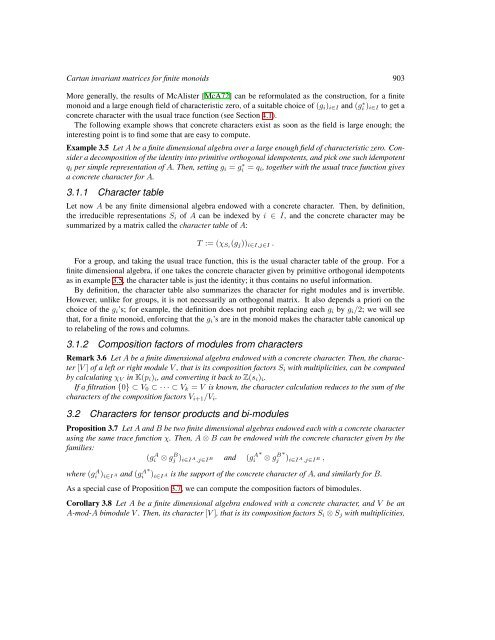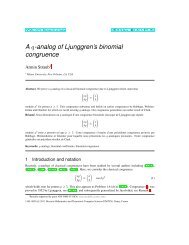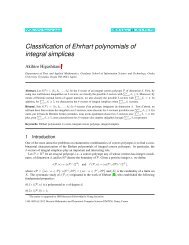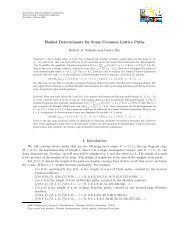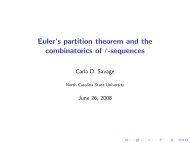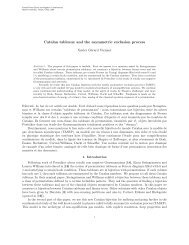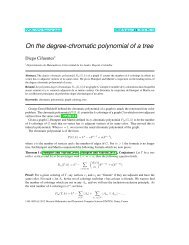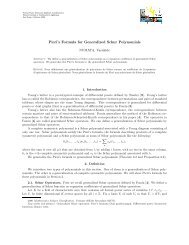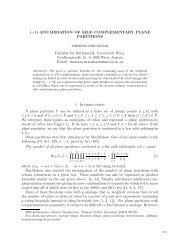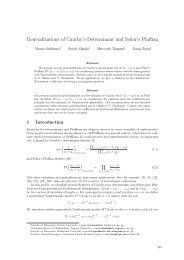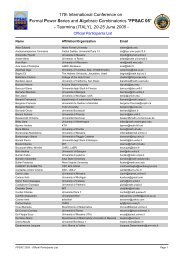Cartan invariant matrices for finite monoids - Nagoya University
Cartan invariant matrices for finite monoids - Nagoya University
Cartan invariant matrices for finite monoids - Nagoya University
Create successful ePaper yourself
Turn your PDF publications into a flip-book with our unique Google optimized e-Paper software.
<strong>Cartan</strong> <strong>invariant</strong> <strong>matrices</strong> <strong>for</strong> <strong>finite</strong> <strong>monoids</strong> 903<br />
More generally, the results of McAlister [McA72] can be re<strong>for</strong>mulated as the construction, <strong>for</strong> a <strong>finite</strong><br />
monoid and a large enough field of characteristic zero, of a suitable choice of (g i ) i∈I and (g ∗ i ) i∈I to get a<br />
concrete character with the usual trace function (see Section 4.1).<br />
The following example shows that concrete characters exist as soon as the field is large enough; the<br />
interesting point is to find some that are easy to compute.<br />
Example 3.5 Let A be a <strong>finite</strong> dimensional algebra over a large enough field of characteristic zero. Consider<br />
a decomposition of the identity into primitive orthogonal idempotents, and pick one such idempotent<br />
q i per simple representation of A. Then, setting g i = g ∗ i = q i, together with the usual trace function gives<br />
a concrete character <strong>for</strong> A.<br />
3.1.1 Character table<br />
Let now A be any <strong>finite</strong> dimensional algebra endowed with a concrete character. Then, by definition,<br />
the irreducible representations S i of A can be indexed by i ∈ I, and the concrete character may be<br />
summarized by a matrix called the character table of A:<br />
T := (χ Si (g j )) i∈I,j∈I .<br />
For a group, and taking the usual trace function, this is the usual character table of the group. For a<br />
<strong>finite</strong> dimensional algebra, if one takes the concrete character given by primitive orthogonal idempotents<br />
as in example 3.5, the character table is just the identity; it thus contains no useful in<strong>for</strong>mation.<br />
By definition, the character table also summarizes the character <strong>for</strong> right modules and is invertible.<br />
However, unlike <strong>for</strong> groups, it is not necessarily an orthogonal matrix. It also depends a priori on the<br />
choice of the g i ’s; <strong>for</strong> example, the definition does not prohibit replacing each g i by g i /2; we will see<br />
that, <strong>for</strong> a <strong>finite</strong> monoid, en<strong>for</strong>cing that the g i ’s are in the monoid makes the character table canonical up<br />
to relabeling of the rows and columns.<br />
3.1.2 Composition factors of modules from characters<br />
Remark 3.6 Let A be a <strong>finite</strong> dimensional algebra endowed with a concrete character. Then, the character<br />
[V ] of a left or right module V , that is its composition factors S i with multiplicities, can be computed<br />
by calculating χ V in K(p i ) i , and converting it back to Z(s i ) i .<br />
If a filtration {0} ⊂ V 0 ⊂ · · · ⊂ V k = V is known, the character calculation reduces to the sum of the<br />
characters of the composition factors V i+1 /V i .<br />
3.2 Characters <strong>for</strong> tensor products and bi-modules<br />
Proposition 3.7 Let A and B be two <strong>finite</strong> dimensional algebras endowed each with a concrete character<br />
using the same trace function χ. Then, A ⊗ B can be endowed with the concrete character given by the<br />
families:<br />
(gi A ⊗ gj B ) i∈IA ,j∈I B and (gA ∗<br />
i ⊗ g<br />
B∗ j )i∈IA ,j∈I B ,<br />
where (gi A) i∈I A and (gA ∗<br />
i )i∈I A is the support of the concrete character of A, and similarly <strong>for</strong> B.<br />
As a special case of Proposition 3.7, we can compute the composition factors of bimodules.<br />
Corollary 3.8 Let A be a <strong>finite</strong> dimensional algebra endowed with a concrete character, and V be an<br />
A-mod-A bimodule V . Then, its character [V ], that is its composition factors S i ⊗ S j with multiplicities,


